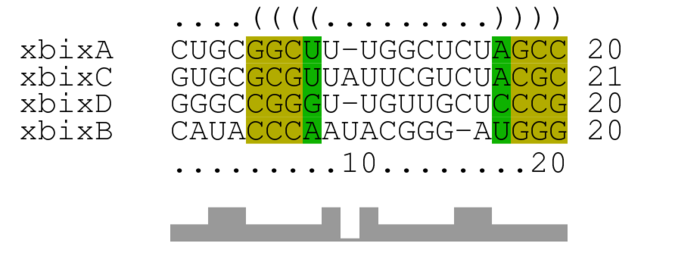Input and runtime details for job 8880963 (precomputed example)
Input Parameter
 Sequence Input in FASTA Format Sequence Input in FASTA Format | [.fa] | ||
 Upload dot plots Upload dot plots | not provided | ||
 Predict dot plots Predict dot plots | without pseudoknots (RNAfold) |
Scoring Parameters
 Structure Weight Structure Weight | 200 | ||
 Indel Opening Score Indel Opening Score | -500 | ||
 Indel Score Indel Score | -350 | ||
 Use RIBOSUM Use RIBOSUM | yes | ||
 Match Score Match Score | 50 | ||
 Mismatch Score Mismatch Score | 0 |
Heuristics for speed/accuracy tradeoff
 Minimal Pair Probability Minimal Pair Probability | 0.01 | ||
 Maximal Difference for Sizes of Matched Arcs Maximal Difference for Sizes of Matched Arcs | 30 | ||
 Maximal Difference for Alignment Edges Maximal Difference for Alignment Edges | 60 |
Other Parameter
 Ignore Constraints Ignore Constraints | no | ||
 Search Time Limit (in milliseconds) Search Time Limit (in milliseconds) | 300000 | ||
 Disallow Lonely Pairs Disallow Lonely Pairs | yes |
Job ID 8880963 (server version trunk)
 | Job Submitted & Queued | @ Fri Jul 22 11:56:40 CEST 2016 | |
 | CARNA Started | @ Fri Jul 22 11:56:56 CEST 2016 | |
 | CARNA Finished & Post-Processing | @ Fri Jul 22 11:56:59 CEST 2016 | |
 | Post-Processing Finished | @ Fri Jul 22 11:58:35 CEST 2016 | |
 | Job Completed | @ Fri Jul 22 11:58:46 CEST 2016 |
Description of the job
multiple conserved structures
In this small example, we align the RNA xbix to three designed variants that fold into the same two conserved structures. xbix was introduced as an example for multiple metastable structures by Wolfinger et al. (/J.Phys.A: Math.Gen./, 2004). It is instructive to compare the alignments of these sequences by CARNA and LocARNA. Whereas CARNA's alignment preserves both conserved structures in the consensus ensemble, LocARNA aligns only one of the two structures correctly and misaligns the other. The example works with the default settings of the server, i.e. dot plots of the ensembles are predicted without pseudoknots by RNAfold. For further illustration, we list the sequences with their conserved structures. xbixA is the original example from Wolfinger et al.
>xbixA CUGCGGCUUUGGCUCUAGCC ....((((........)))) (((.(((....))).))).. >xbixB CAUACCCAAUACGGGAUGGG ....((((........)))) (((.(((.....)))))).. >xbixC GUGCGCGUUAUUCGUCUACGC ....((((.........)))) (((.(((.....))).))).. >xbixD GGGCCGGGUUGUUGCUCCCG ....((((........)))) (((.(((....))).)))..
 Conservation dot plots for xbix variants A-D, the consensus conservation
dot plot of CARNA's alignment and the consensus conservation dot plot of
the alignment by LocARNA. The LocARNA consensus dot plot shows a
misalignment of the inner stem of one of the two conserved structures.
Only CARNA can simultaneously align both structures and aligns this stem
and all other base pairs correctly. The misalignment by LocARNA is also
seen by annotating LocARNA's alignment with the two conserved structures:
Conservation dot plots for xbix variants A-D, the consensus conservation
dot plot of CARNA's alignment and the consensus conservation dot plot of
the alignment by LocARNA. The LocARNA consensus dot plot shows a
misalignment of the inner stem of one of the two conserved structures.
Only CARNA can simultaneously align both structures and aligns this stem
and all other base pairs correctly. The misalignment by LocARNA is also
seen by annotating LocARNA's alignment with the two conserved structures:
>xbixA CUGCGGCUUUGGCU-CUAGCC ....((((......-..)))) (((.(((....)))-.))).. >xbixC GUGCGCGUUAUUCGUCUACGC ....((((.........)))) (((.(((.....))).))).. >xbixD GGGCCGGGUUGUUG-CUCCCG ....((((......-..)))) (((.(((....)))-.))).. >xbixB CAUACCCAAUACGGG-AUGGG ....((((.......-.)))) (((.(((.....)))-)))..
Outputdownload complete results [zip]
Conservation Dot Plots
Loading image 
For interpretation of the colors see the legend below. For a detailed description of the output, please see the help page.
Color Legend
The lower left triangle of the dot plots contains the average dot plot colored with variance information. Pure green means maximum variance (e.g. in half of the sequences the dot has probability 0 and in the other half it has probability 1); pure red means no variance at all (the dot has the same probability in all sequences).

Alignment annotated with pseudoknot-free consensus structure

Bases are encoded by IUPAC codes. For interpretation of the colors see the legend below. For a detailed description of the output, please see the help page.
Color Legend

Job resubmission
 usability assessment
usability assessment
When using CARNA please cite :
- Dragos A. Sorescu, Mathias Moehl, Martin Mann, Rolf Backofen, and Sebastian Will
CARNA - alignment of RNA structure ensembles
Nucleic Acids Reseach, 2012, 40 no. W1 pp. W49-W53 - Alessandro Dal Palu, Mathias Moehl, Sebastian Will
A Propagator for Maximum Weight String Alignment with Arbitrary Pairwise Dependencies
Proceedings of the 16th International Conference on Principles and Practice of Constraint Programming (CP-2010), 2010, 8 - Martin Raden, Syed M Ali, Omer S Alkhnbashi, Anke Busch, Fabrizio Costa, Jason A Davis, Florian Eggenhofer, Rick Gelhausen, Jens Georg, Steffen Heyne, Michael Hiller, Kousik Kundu, Robert Kleinkauf, Steffen C Lott, Mostafa M Mohamed, Alexander Mattheis, Milad Miladi, Andreas S Richter, Sebastian Will, Joachim Wolff, Patrick R Wright, and Rolf Backofen
Freiburg RNA tools: a central online resource for RNA-focused research and teaching
Nucleic Acids Research, 46(W1), W25-W29, 2018.




 Click on the dot plot to enlarge it.
Click on the dot plot to enlarge it.
